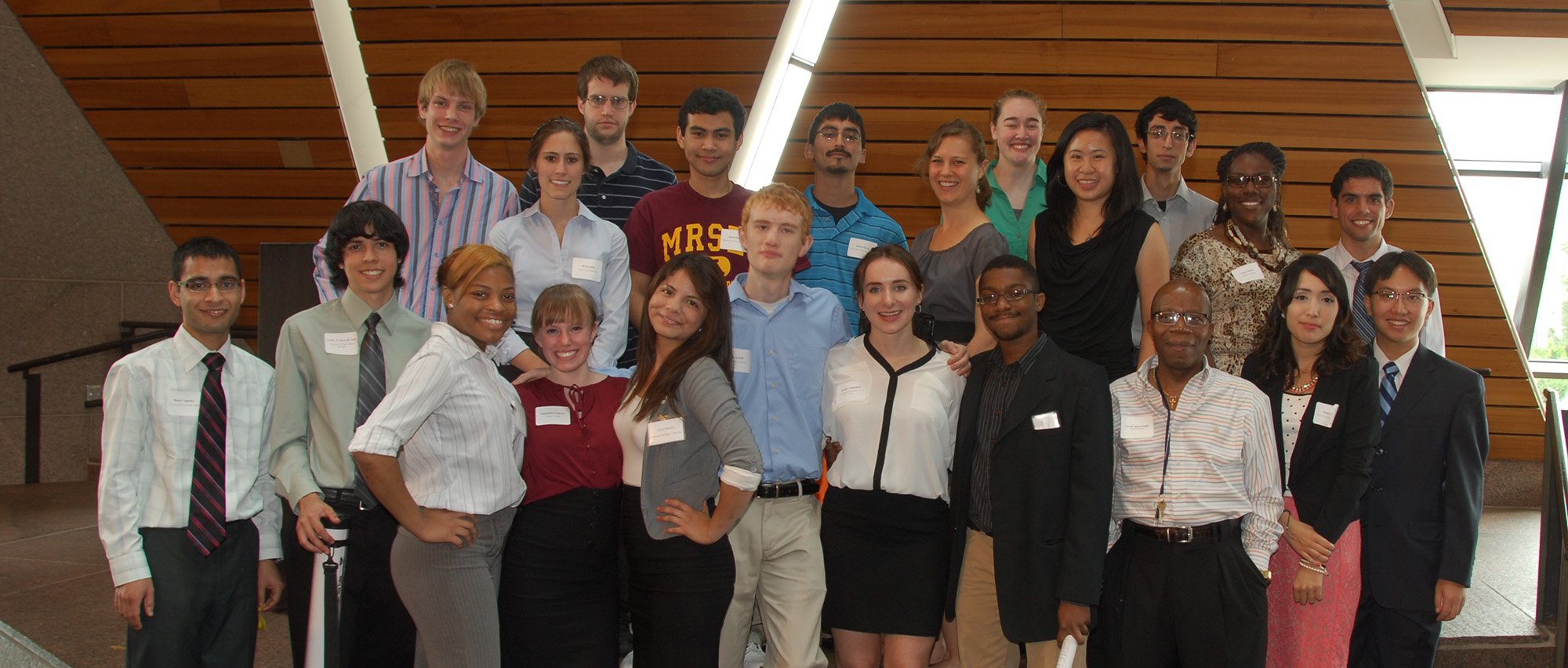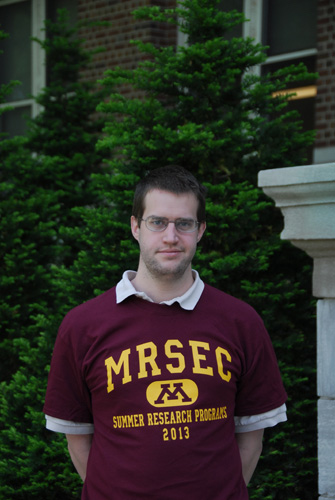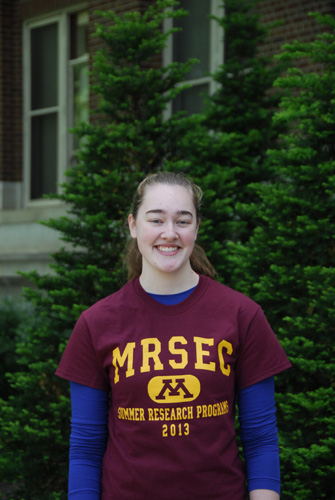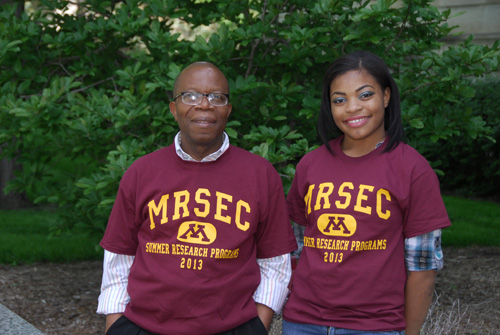

Home Institution: Colorado School of Mines
MRSEC Mentor: Chris Macosko
Surface Modification of Nylon 6 and Polyvinyldiene Fluoride Melt Blown Nanofibers
Nylon 6 (polyamide 6) is a common polymer with various industrial applications, such as in filtration media. Polyvinyldiene fluoride (PVDF) is a polymer with various desirable properties, such as surface hydrophobicity. These two polymers will be melt blended and melt blown in various proportions to create melt blown nanofibers. It is expected that the PVDF molecules will migrate to the surface of the polymer blend, and melt blowing will produce fibers with a hydrophobic surface. The hope is that modifying the surface of nylon 6 in this manner will allow for the creation of a filtration media that is more effective and durable and easier to clean than pure nylon filters.This research will examine the miscibility between nylon 6 and PVDF, the interfacial tension between the two polymers, the surface properties of the polymer blends, and the morphology of the melt blown fibers. Methods used to study the fibers will include scanning electron microscopy.

Home Institution: UW Whitewater
MRSEC Mentor: Chris Leighton
It is widely known that many substances change their electrical resistance upon exposure to a magnetic field, in a manner dependent on the nature of that field. This property, known as magentoresistance, has a wide variety of potential applications, especially in digital data storage. The creation of a network comprised of nodes and bridges with easily alterable electromagnetic properties would be quite useful in the development of magnetic memory; however, the small scales required make generating such an arrangement nontrivial. The work to be performed will involve coating a substrate with a thin film of a significantly magnetoresistant polymer and using both chemical and physical etching techniques to produce a pattern of holes in the polymer layer that will approximate a network of nodes and bridges. Specifically, a smooth wafer of lanthanum strontium cobalt oxide (LaSrCoO3) will be used, after preparation and cleaning, as a substrate. It will then be coated with a solution containing polystyrene and polylactate using a standard spin-coating technique. Upon initial application, the polymer coating will be nonuniform, and therefore unsuitable for the etching process. An annealing process will swell the film and cause the polymers to align in a predominantly uniform pattern of cylinders. Due to the differing miscibilities of the two polymers, exposure to tetrahydrofuran (THF) will dissolve these cylinders more quickly than the surrounding polymer, eventually resulting in an even thinner film with a uniform pattern of holes. The resulting samples will then be tested for a variety of electromagnetic properties.

Home Institution: University of Texas Pan American
Major/Minor: Chemistry
MRSEC Mentor: Chris Douglas
Progress Towards Synthesis of Rubrene Derivatives for Single Crystal Organic Field-Effect Transistors
Rubrene, an organic semi-conductor, is known to demonstrate advantageous physical and electronic properties as an organic field-effect transistor, most notably with it’s high calculated charge carrier mobility at room temperature. Previously observed beneficial attractive interactions between electron-rich and electron-withdrawing aryl substituents on rubrene’s tetracene core are believed to contribute to exhibited pi-stacking in each rubrene derivative’s solid-state, an essential aspect in electron transport in a single-crystal device. However, an exact relationship between molecular and crystal structure, and resulting effects on charge transport in rubrene has not yet been fully established. In this study, congeners of rubrene with aryl substituents containing methoxy (electron-donating) and trifluoromethyl (electron-withdrawing) groups are synthesized via an eight-step process from known 1,4-Napthoquinone. Efforts of this synthesis of rubrene derivatives are directed largely toward crystallization and charge-transport studies in single-crystal organic field-effect transistors in attempt to expand knowledge and understanding of a structure-property relationship.

Home Institution: UW Stout
MRSEC Mentor: David Flannigan
Characterization of Transfer Artifacts of CVD-Grown Graphene Monolayers
Graphene was the first two-dimensional material to be isolated and studied. Made entirely
of carbon atoms arranged in a honeycomb-like sheet, its unique electrical, mechanical and optical
properties make it a promising material for applications in electronic devices. Chemical vapor
deposition (CVD) provides a route to industrial-scale production of graphene, but necessitates
transfer from the catalytic metal on which the film is deposited. The transfer process can introduce
defects on otherwise pristine graphene, which severely limit the potential of graphene-based
technology. The transfer artifacts are studied with optical, confocal Raman and transmission electron
microscopy to evaluate the quality of suspended films transferred via a polymer-mediated method.
These techniques reveal polymer residue, metal nanoparticles, folds, wrinkles and tears. Transfer
methods are tested and modified to produce a graphene monolayer suspended on carbon-coated
TEM grids with micron-range continuity.

Home Institution: SUNY Buffalo
MRSEC Mentor: Lorraine Francis
AFM-based Observations of Composite Latex Particles
Water-borne latex dispersions undergo film formation upon drying as polymer particles
coalesece to form a homogenous coating. Particles containing soft polymers with low glass
transition temperatures (Tg) easily form a film at room temperature, but these films typically lack
desired mechanical properties. Alternatively, particles containing hard polymers with high Tgs are
valued for their mechanical strength and stability, but lack the ability to film-form without the
addition of volatile additives. Balancing the desirable features of low and high Tg polymer particles
can be achieved by engineering composite latex particles. These particles, containing core-shell
morphology, combine the mechanical strength of a hard shell (high Tg) with the film-forming abilities
of a soft core (low Tg). In this work, the effects of temperature, particle size, and Tg on the extent of
film-formation will be studied. Using atomic force microscopy, film-formation was quantified by
surface changes in peak-to-peak distances, particle shapes, and peak-to-valley distances. These
characterization parameters indicated that small particle latex dispersions form better fil

Home Institution: Georgia Tech
Major/Minor: Mechanical Engineering
MRSEC Mentor: Jian Ping Wang
Transport Properties and Scanning Electron Microscopy Study of Spin Logic Devices
The use of spin in logic applications has many potential advantages over the use of charge based devices such as CMOS in terms of power consumption. Also, by using spin logic devices, it is possible to change the magnetic configuration of nanomagnets via providing sufficient current, known as spin transfer torque. These nanomagnets would produce high resistance states or low resistance states depending if the orientation of the nanomagnets are aligned antiparallel or parallel to each other. This change in resistance can correspond to different logic bits and has applications such as allowing signals to be transferred to certain input and output magnets for logic functions. To study spin logic samples, a lock-in amplifier will be used for electrical measurements and a program needs to be developed in order to utilize the lock-in amplifier. Electrical instruments will be used to analyze the resistance states of the sample during application of an external magnetic field or applied current for spin transfer torque. Scanning electron microscopy images will also be used to analyze the physical structure of the samples.

Home Institution: Dillard University
MRSEC Mentor: Laura Gagliardi
Carbon Dioxide Interaction with N-N'-dimethylethylenediamine
The use of Metal Organic Frameworks (MOFs) is becoming increasingly popular in the
scientific community. These crystalline, three-dimensional, porous materials are composed of metal
ions and organic ligands, and have been used for a wide variety of applications ranging from
catalysis to gas separation and storage. One application that has piqued interest, due to the rising
concerns about atmospheric pollutants, is Carbon Capture and Sequestration (CCS). Previous
research performed by the Gagliardi group (U of M) in collaboration with the Long group (UC
Berkeley) performed a DFT mechanistic study that tackled the capture of carbon dioxide (CO2) by
N, N’–dimethylethylenediamine (mmen) anchored to the MOF Mg2-(dobpdc), where dobpdc2- is 4,
4’–dioxidobiphenyl-3, 3’ –dicarboxylate) and explained the experimentally observed 1:1 (CO2:
amine) stoichiometry by an effective 2:2 stoichiometry yielding a bas-carbamic acid complex. CO2
capture by amines in aqueous media occurs through a 1:2 stoichiometry reaction, and the product
consists of carbamate and ammonium adduct. Inside of the MOF, the corresponding intermediate
species exists as neutral carbamic acid hydrogen bound to an amine. This work investigates the
nature of carbamate-ammonium complex species in the gas phase for mmen derivate species
containing different substituents.

Home Institution: St. Olaf College
Major/Minor: Physics and Mathematics
MRSEC Mentor: Andre Mkhoyan
Optimizing Liquid-phase Exfoliation of h-BN and MoS2
Monolayers of Boron Nitride (BN), as well as Molybdenum Disulfide (MoS2), have special electronic and mechanical properties that could be used in a large variety of applications. Prior to achieving such monolayers, the flakes produced in the liquid-exfoliation process must be optimized for size, specifically thinkness. To optimize the flakes from the exfoliation process, we will study the effects of different solvents, sonication times, centrifuge speeds and times, and deposition methods. The optimized process will be established by the concentration of the flakes determined from the absorbance spectra, as well as by the size and thickness of the flakes from atomic force microscopy (AFM) and transmission electron microscopy (TEM) analysis.

Home Institution: University of Puerto Rico-Mayaguez
Complexation of Silver ions by Natural Organic Matter as Studied Using Fluorous-Phase Ion-Selective Electrodes
Silver nanoparticles (AgNPs) are used extensively in both medical and consumer industries as antimicrobial agents. The antibacterial nature of AgNPs is primarily due to ionization and dissolution of these particles and release of Ag+ into the environment, which can bind to proteins, enzymes and DNA and disrupt normal cell function. Therefore, it is critical to understand the extent and kinetics of dissolution to Ag+ and the environmental effects on the released Ag+ to understand AgNP toxicity. Natural organic matter, NOM, which originates from remaining of living organisms and is abundant in surface and ground water supplies, can interact with the released Ag+ resulting in silver ion speciation, decreased bioavailability and altered toxicity. Therefore, understanding chemical equilibrium between Ag+ and NOM is critical for a correct assessment of toxicity and environmental impacts of AgNPs. Fluorous-phase Ion-selective Electrodes provide selective measurements for Ag+. These will be used to study the interaction of NOM and Ag+. Unlike hypothesized in many studies, findings suggest no significant binding between Ag+ and NOM at environmentally relevant conditions. Moreover, pH dependence of complexation of NOM and Ag+ was investigated. It was shown that at basic pH weak complexation between NOM and Ag+ can be observed whereas at acidic and neutral pH there is no significant complexation of NOM and Ag+.

Home Institution: University of Minnesota
MRSEC Mentor: Joe Zasadzinski
Synthesis and Characterization of Monodisperse, Near-Infrared Light Absorbing Nanoparticles for Targeted Drug Delivery in Cancer Therapy
Conventional cancer treatments, such as surgery, chemotherapy, and radiology, are invasive to the body and inefficient in removing all cancer cells. Targeted drug delivery can improve the efficacy of these treatments by using spatial and temporal control to release drugs at the tumor site. This reduces damage to normal tissue and increases drug concentrations near the tumor, making the treatment less toxic and more effective. Our project focuses on the synthesis of nanoparticles that can be used with lipid-based drug carriers and laser irradiation to deliver cancer drugs. We are interested in nanoparticles that absorb near-infrared (NIR) light, which penetrates human tissue effectively. These particles should also be monodisperse to maximize the laser energy that is transformed to thermal heat. Finally, they should be biocompatible and non-toxic. Silver, copper sulfide, gold/gold sulfide nanoparticles, and hollow gold nanoshells were synthesized for this study. They were characterized with transmission electron microscopy (TEM), dynamic light scattering (DLS), UV-Vis spectroscopy, and the NanoSight instrument in order to compare their morphologies, size distributions, and absorptions. Our results show biocompatible, monodisperse—10, 25, 35, 45, 60 nm— nanoparticles that have absorptions in the NIR region, ranging from 720 – 950 nm. In the future, these nanoparticles will be combined with liposomes to study their interaction with picosecond NIR laser irradiation for cancer chemotherapy.

Home Institution: UC Berkeley
Major/Minor: Chemical and Biomolecular Engineering and Materials Science and Engineering
MRSEC Mentor: Eray Aydil
The effects of alkali impurities on the electronic properties of Cu2ZnSnS4 thin films for photovoltaic devices
Copper Zinc Tin Sulfide (Cu2ZnSnS4 or CZTS) is a novel quaternary semiconductor consisting of abundant and non-toxic elements, and due to its high absorption coefficient (α > 104 cm-1), it is an ideal candidate for the absorbing layer in thin film solar cells. Synthesizing high quality, phase-pure CZTS remains a challenge, however, since many variables affect its formation. One key aspect to the synthesis of CZTS lies in the choice of substrate, namely soda-lime glass (SLG). SLG contains a variety of impurity atoms, including Na and K, which uncontrollably diffuse into the CZTS layer. These impurities have been shown to promote grain growth and improve solar cell performance. To better understand the influence of Na and K, we will synthesize CZTS on impurity-free sapphire. We first co-sputter a Cu-Zn-Sn thin film, and then load the metal film and 1 mg of S into a quartz ampoule coated with varying amounts of KOH or NaOH that are eventually incorporated into the CZTS. The ampoule is then evacuated, sealed, and heated in a furnace for 8 hours at 600oC. We will measure the electronic properties of the resultant CZTS films, including carrier concentration and resistivity as a function of temperature and as a function of the amount of impurity present during sulfidation. This will allow us to gain a deeper understanding as to how impurities ultimately affect the performance of CZTS solar cell devices.

Home Institution: University of Texas Pan American
Major/Minor: Chemistry/ Biology and Business Administration
MRSEC Mentor: Efie Kokkoli
Polymer Scaffold for Tissue Engineering
Polymer scaffolds have emerged as a potent tool in various areas of tissue engineering. Recent advances have shown that they can be employed as versatile 3-dimensional matrixes for cultivating cells and in the formation of targeted tissue growth. Hydrogels, in particular shown immense promise as scaffold materials based on their structural similarity to the extracellular matrix of several tissues. In this project, we hope to synthesize block copolymers based on low molecular weight poly (lactide-co-glycolide) (PLGA) copolymers using ring opening polymerization and their subsequent characterization. Ultimately, it is envisioned that these unique block polymer hydrogels will greatly aid in the adhesion, differentiation and proliferation of cells with potential applications as tissue replacements.

Home Institution: University of Texas Pan American
Major/Minor: Mechanical Engineering
MRSEC Mentor: Victor Barocas
Experimental Characterization of Collagen Pre-Stress Using Collagen-Hyaluronic Acid Co-Gels
Collagen gel tissue-equivalents (TEs) have been used to examine the many properties of soft tissues because of its tunable properties. Some properties that have been explored from these TEs are how structural and compositional properties affect their mechanical function. One aspect not captured in the past TEs, is residual stress through interaction among components with different mechanical rest states. Since TE fabrication cannot easily replicate the in vivo stress state of native tissues, a different method was needed to induce pre-stress in collagen networks. In order to duplicate this pre-stress, co-gel TEs were fabricated by adding hyaluronic acid (HA) to reconstituted Type I collagen (Col) gels. HA was used to produce the pre-stress in the collagen networks due to the fact that when placed in a hypotonic solution, HA swells from the build up of osmotic pressure arising from the Donnan effect. This in turn stretches and stresses the collagen networks, so that TEs with residual stress (i.e., pre stressed collagen fibers) can be created and reviewed to elucidate the relationships between residual stress and their functional properties. For that reason, the goal of this research is to fabricate HA-Col TEs, in order to determine their swelling properties and to measure the amount of pre-stress introduced to the collagen networks.

Home Institution: University of Texas Pan American
Major/Minor: Mechanical Engineering
MRSEC Mentor: Uwe Kortshagen/Eray Aydil
Optical Characterization of Nonthermal Argon-Silane Discharges
Silicon nanocrystals have gained much attention in recent years due to their excellent semiconductive properties that prompt their use in light-emitting diodes (LEDs), photovoltaic (PV) cells, and other optoelectronic devices. Synthesis of these nanoparticles has been achieved through many techniques, but none offer the advantages of plasma-phase processing, which is known to be environmentally benign. For instance, liquid-phase syntheses of nanocrystals are associated with effluents that can be difficult and costly to clean and are typically connected with low concentrations of intended product. Therefor, optically studying the production of silicon nanocrystals through a nonthermal plasma can contribute highly in understanding one of the ideal methods of synthesizing semiconductive powders. Using a monochromator and charge coupling device (CCD), time and spatially resolved optical emission spectra from these discharges can be recorded and used to determine electron temperature and various species densities. LASER light scattering will be captured using a CCD to determine the locations of nanoparticles in the plasmas during their development. A Langmuir probe may also be used to measure ion and electron densities and temperatures. This data will be compared to computational results to better comprehend spatiotemporal evolution of nanoparticle growth, position, and charging.

Home Institution: University of Minnesota
Major/Minor: Chemical Engineering
MRSEC Mentor: Michael Tsapatsis
Synthesis and Optimization of Silica Supports for Thin-Film Zeolite Membranes
MFI-zeolite membranes have shown great potential as an energy-efficient means of separating water from ethanol. Currently, however, the cost-efficiency ratio of the zeolite membranes does not yet make them attractive for use in industry. Thin, oriented zeolite membranes can improve the performance and make them attractive for large-scale implementation. Silica support structures are being investigated due to their unique ability to facilitate synthesis of ultrathin, b-oriented crystal morphology for higher flux. The difficulty of this method arises in the mircoporous nature of the silica nanospheres used to fabricate the supports, causing shrinking and cracking when the supports are sintered. The synthesis of monodisperse silica nanospheres with 500nm and 300nm diameters will be studied by optimizing the established Stober process and characterized with Dynamic Light Scattering (DLS). The sintering conditions will also be studied with the goal of optimizing the mechanical stability of the support structures without compromising porosity.

Home Institution: Anoka Ramsey Community College
Major/Minor: Electrical Engineering / Math
MRSEC Mentor: Dan Dahlberg
Measuring the Magnetostriction of Magnetic Rods in a Jell
Magnetostrictive materials convert magnetic energy to mechanical energy and vice versa. Magnetizing a magnetostrictive material which is ferromagnetic causes a strain which changes the dimensions of the material. Magnetostriction is an intrinsic material property that will not degrade with time. The main goal of this project is to produce a magnetostrictive material with a greater displacement than currently used magnetostrictive materials. This project has technological implications as magnetostriction based devices are used for both actuation and sensing devices such as radio, mobile phones which would be essential to tele-communication companies, and the military services. The first step is to make cobalt nanowires by electro deposition and put them in a tube containing a jell like polymer. After the polymer has set, it will be removed from the tube and a thin mirror will be set on the top of the polymer tube and a wooden block of similar height. A laser beam can be deflected from the mirror to a wall or suitable viewing screen several meters away. If the height of the polymer changes the incident and reflection angles will change and the position of the reflected beam on the wall will therefore change. A magnetic field will be applied to the polymer tube both along the length of the tube and perpendicular to the height. It is anticipated that the rotation of the cobalt wires will align with the applied field and will alter the polymer tube height. The cobalt will be ideal for this application because of both its mechanical and magnetic properties.

Home Institution: University of Texas Pan American
MRSEC Mentor: Andreas Stein
Nanocomposite Cathodes for Rechargeable Lithium Ion Batteries
Lithium ion batteries provide a reliable source of electric power for transportation and
portable devices. However, they maintain a low power density and are susceptible to significant loss
of capacity over cycles. Through careful selection of cathode materials and design of nanoscale
architecture, current challenges with conductivity and volume expansion can be overcome. Threedimensionally
ordered mesoporous and macroporous (3DOm/3DOM) carbon hosts were prepared
separately and infiltrated by precursors, which were then successfully converted into the active
material. Theoretically, the active material promises a large capacity, while the carbon and porosity
of the hosts’ structure deliver a matrix of conductivity and an improvement in mass transport of
lithium ions, thus yielding higher power density. Additionally, the carbon’s structure enhances
cyclability by confining the volume of the active material within its pores. XRD and SEM confirm the
synthesis of the active material within the carbon and the presence of porosity.

Home Institution: Florida A&M
Major/Minor: Chemistry
MRSEC Mentor: Ron Siegel
RAFT polymerization of ABC triblock: Poly(N-isopropylacrylamide) - poly(acrylamide-co-acrylic acid) - poly(N,N-diethylacrylamide)
Reversible hydrogels that respond to pH and temperature stimuli are of interest, for their many possible functions such as drug delivery agents, cell immobilization, and tissue engineering. Poly(N-isopropylacrylamide) - poly(acrylamide-co-acrylic acid) - poly(N,N-diethylacrylamide), PNIPAm-P(AAm-co-AA)-PDEAm, will be synthesized by reversible addition-fragmentation chain transfer (RAFT) polymerization. The A and C blocks are composed of PNIPAm and PDEAm, which are well known temperature responsive polymers. The B block is a copolymer of AAm and AA. In literature poly(acrylamide) gels have been shown to be adept at immobilization of enzymes and delivery of drugs and bioactive compounds, while poly(acrylic acid) is a well known pH sensitive polymer that has been used as thickener in paints and a water absorbing agent in disposable diapers. The ABC triblock terpolymer exhibits sensitivity to both temperature and pH, due to its respective compounds. In a high temperature environment, the polymer is expected to form a physical hydrogel. Unlike, traditional hydrogels which have a covalent bonded structure, PNIPAm-P(AAm-co-AA)-PDEAm is expected to undergo reversible sol to gel transition. Furthermore, the swelling and shrinking of the hydrogel can be controlled by pH.

Home Institution: Carleton College
Major/Minor: Physics
MRSEC Mentor: Uwe Kortshagen
Gas-Phase Surface Passivation of Silicon Nanocrystals for Light-Emitting Devices
Nanoparticles have been intensely researched in recent years due to unique properties relying on quantum mechanical effects. In particular, Silicon Nanocrystals (SiNCs) are promising for such applications as solar cells and light-emitting devices (LEDs) because of their tunable wavelength emission. For SiNCs to become more accessible for industrial applications, a simple and efficient synthesis process is needed. One promising method is an all-gas-phase approach where SiNCs are synthesized using a low-pressure nonthermal plasma. With this method it is possible to create SiNCs in a single reactor also used for fabricating LEDs. However, SiNCs synthesized in this way have poor quantum yield. We hope to increase the quantum yield of SiNCs from gas-phase surface passivity using ultraviolet light.

Home Institution: Puerto Rico Mayaguez
MRSEC Mentor: Ben Hackel
Structural Analysis of Fibronectin Ligand Proteins
This project aims to determine the three-dimensional structure of small molecules,
specifically fibronectin domain-mutants using x-rays crystallography. The laboratory has previously
engineered fibronectin domain-mutants that bind with high affinity and specificity to molecular
targets for clinical and biotechnology utility. We try to produce high yields of these domain mutants
that consist of the core amino acids and minimal extraneous tags. To achieve this, we prepare DNA
plasmids that encode for the fibronectin domain with removable purification tags. Multiple
fibronectin mutant genes are moved into this DNA expression vector to then successfully produce
and purify multiple fibronectin domains. Finally, attachments to these molecules are removed by
breaking the protein into two smaller peptides. Future aims will consist of identifying the right
conditions in which fibronectin domains will form consistent crystals useful for structural
determination. X-ray diffraction information will be collected to identify the crystal structure of the
fibronectin domains.

Home Institution: Century College
MRSEC Mentor: Paul Crowell
The nano-scale structures of ubiquitous, everyday materials has become an area of extreme interest since the success of Graphene. The electro-magnetic character of certain transition metals, and/or dichalcogenides have promising capabilities for the future of electronics, if only we can apply nano-sized components and test their physical properties. One of those dichalcogenides that will be studied here is molybdenum disulfide (MoS2), in which the properties of MoS2 in bulk differ from those of it's monolayer. By using the scotch tape micro-cleavage technique used in the exfoliation of graphene, we will acquire single-layer, nano-sized flakes of MoS2 and transfer them to a silicon substrate for electronic fabrication. Once these micro-devices are assembled, we will carry out regular physics experiments to determine there properties, in the hope that they will perform as the dynamic material we hope them to be.

Home Institution: University of Illinois at Springfield
MRSEC Mentor: Lee Penn
Solution synthesis and optimization of kesterites onto flexible substrates using microwave heating
In this project, we propose to grow kesterite thin films, such as copper zinc tin sulfide (CZTS) and copper iron tin sulfide (CFTS), for photovoltaic applications. The thin films will be synthesized by selective heating of conductive substrates (ITO, Mo-coated glass, and Mo-coated Kapton) using a microwave assisted synthesis at low temperatures. The synthesis will be optimized to find the right metal precursor, temperature, power, and solvent. The synthesized thin film materials will be characterized using X-ray diffraction (XRD), Raman spectroscopy, Scanning Electron Microscopy (SEM), and Energy-Dispersive X-ray Spectroscopy (EDS). X-ray diffraction is utilized to verify the crystal structure of the synthesized material and Raman spectroscopy is used to verify the phase of the structure based on its vibrational and rotational modes and also identify any contaminants present. Scanning Electron Microscopy will be useful in obtaining the image of the film, identifying its thickness and crystallite size. Finally, Energy-Dispersive X-ray spectroscopy will be used to provide elemental information in the crystallite structure.

Home Institution: Dillard University
MRSEC Mentor: Michael Tsapatsis
Optimization of the Procedure to Synthesize OSDA
Synthetic zeolites have a multitude of applications in today’s world. However, a zeolite’s
efficiency depends upon several factors such as pore size, thickness and smoothness, all of which
are impacted by the purity of the starting material. This starting material is a bi-quaternary
ammonium salt, which is produced through a lengthy process. Because this process is lengthy, there
are many opportunities for error to occur and result in an impure product or low product yield.
Therefore, the aim is to optimize this process at every available opportunity. To optimize this
procedure, the original procedure was done and the steps that seemed problematic were noted.
Ways to improve these steps were then researched and tested. These improvements were in regards
to the chronologic order of the steps, mode of addition of the reactants and calculation of molarity.
Through these improvements, the new, optimized procedure resulted better results in regards to yield
and purity.

Home Institution: Oberlin College
MRSEC Mentor: Paige Novak
The Effects of PFOS on Membrane Permeability
Perfluorocarbons (PFCs), used in domestic and industrial applications, have been found as
contaminants in surface water, ground water, sediment, and some birds and mammals. Due to their
surfactant nature, PFCs could increase lipid bilayer membrane permeability. Limited research on the
effects of PFCs has been conducted in mice. I examined the effect of perfluorooctanesulfonic acid
(PFOS), a widely-used PFC, on membrane permeability of Nitrosomonas bacteria. This is important
because increased membrane permeability could allow co-contaminants to infiltrate these
bacteria. Permeability can be tested with and without PFOS using an artificial black lipid membrane
(BLM) to simulate a lipid bilayer. The membrane permeability can be examined by measuring the
flow of protons across the BLM. Future research includes testing ions such as chloride and larger
hydrophobic substances such as naphthalene. These findings complement experiments that are
fluorescently tagging toxins to monitor whether the presence of PFOS increases permeation in
Nitrosomonas.
UMN MRSEC
435 Amundson Hall, 421 Washington Ave. SE, Minneapolis, MN, 55455
P: 612-626-0713 | F: 612-626-7805